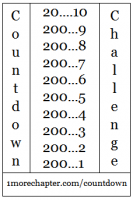I finished the What’s in a Name? 3 Challenge with a very different list than I anticipated at the beginning of the year. Only one book remained the same, but changing it up during the year is fun, too!
Between January 1 and December 31, 2010, read one book in each of the following categories:
of the following categories:
(Food) in the title: The Dark Days of Hamburger Halpin by Josh Berk
(Body of water) The Sea of Monsters (Percy Jackson & the Olympians #2 by Rick Riordan
(Title, like queen, president) The Queen of Attolia (The Queen’s Thief #2) by Megan Whalen Turner
(Plant) Tallgrass by Sandra Dallas
(Place name, like city, country) Tropical Secrets: Holocaust Refugees in Cuba by Margarita Engle
(Music term) The Piano Lesson by August Wilson
 I finished this reading challenge 3 months early! The goal of the challenge is to read the number of books first published in a given year that corresponds to the last digit of each year in the 2000s — 10 books from 2010, 9 books from 2009, 8 books from 2008, etc. The total number of books required, therefore, is 55. The challenge lasts from 9/9/09 through 10/10/10.
I finished this reading challenge 3 months early! The goal of the challenge is to read the number of books first published in a given year that corresponds to the last digit of each year in the 2000s — 10 books from 2010, 9 books from 2009, 8 books from 2008, etc. The total number of books required, therefore, is 55. The challenge lasts from 9/9/09 through 10/10/10.





























